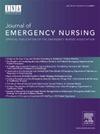The Role of Structural Empowerment in Mediating the Relationship Between Practice Environment and Quality of Care Among Emergency Nurses: A Multilevel Modeling Approach
IF 2.3
4区 医学
Q2 EMERGENCY MEDICINE
引用次数: 0
Abstract
Introduction
Strong evidence demonstrated that working in a healthy environment has been associated with high-quality patient care. However, the mechanism underlying this relationship requires further investigation. This study aimed to examine the role of structural empowerment in mediating the relationship between nursing practice environment and quality of care among emergency nurses.
Methods
A proportional stratified clustered sampling technique was used to recruit staff nurses working in acute care hospitals in Oman. Four standardized instruments were used to assess nurses’ sociodemographic characteristics, perception of the practice environment, structural empowerment, and perceived quality of care. Hayes’ process for mediation analysis was used to examine whether empowerment mediates the relationship between the practice environment and quality of care.
Results
A total of 160 emergency nurses participated. The majority (78.8%) perceived the quality of care as good/excellent. Having an adequate foundation for quality of care, sufficient staffing, and managerial support were significant predictors of perceived quality of care. Practice environment was directly and indirectly related to the perceived quality of care through structural empowerment.
Discussion
Nurse leaders can enhance care quality in emergency departments by improving the work environment through engaging nurses in quality activities, ensuring adequate staffing and resources, and providing robust leadership support, which collectively empower nurses and improve patient outcomes.
结构授权在急诊护士执业环境与护理质量关系中的中介作用:一个多层次的建模方法。
强有力的证据表明,在健康的环境中工作与高质量的患者护理有关。然而,这种关系背后的机制需要进一步研究。本研究旨在探讨结构授权在急诊护士护理实践环境与护理质量之间的中介作用。方法:采用比例分层整群抽样的方法,对阿曼急症医院护士进行调查。采用四种标准化工具评估护士的社会人口学特征、对执业环境的感知、结构赋权和感知护理质量。采用Hayes的中介分析过程来检验授权是否在实践环境和护理质量之间起中介作用。结果:共有160名急诊护士参与。大多数人(78.8%)认为护理质量好/优秀。拥有足够的护理质量基础,充足的人员配备和管理支持是感知护理质量的重要预测因素。实践环境通过结构赋权与护理感知质量直接或间接相关。讨论:护士领导可以通过让护士参与高质量的活动来改善工作环境,确保充足的人员配备和资源,并提供强有力的领导支持,从而提高急诊科的护理质量,这些共同赋予护士权力并改善患者的预后。
本文章由计算机程序翻译,如有差异,请以英文原文为准。
求助全文
约1分钟内获得全文
求助全文
来源期刊
CiteScore
3.10
自引率
11.80%
发文量
132
审稿时长
46 days
期刊介绍:
The Journal of Emergency Nursing, the official journal of the Emergency Nurses Association (ENA), is committed to the dissemination of high quality, peer-reviewed manuscripts relevant to all areas of emergency nursing practice across the lifespan. Journal content includes clinical topics, integrative or systematic literature reviews, research, and practice improvement initiatives that provide emergency nurses globally with implications for translation of new knowledge into practice.
The Journal also includes focused sections such as case studies, pharmacology/toxicology, injury prevention, trauma, triage, quality and safety, pediatrics and geriatrics.
The Journal aims to mirror the goal of ENA to promote: community, governance and leadership, knowledge, quality and safety, and advocacy.

 求助内容:
求助内容: 应助结果提醒方式:
应助结果提醒方式:


